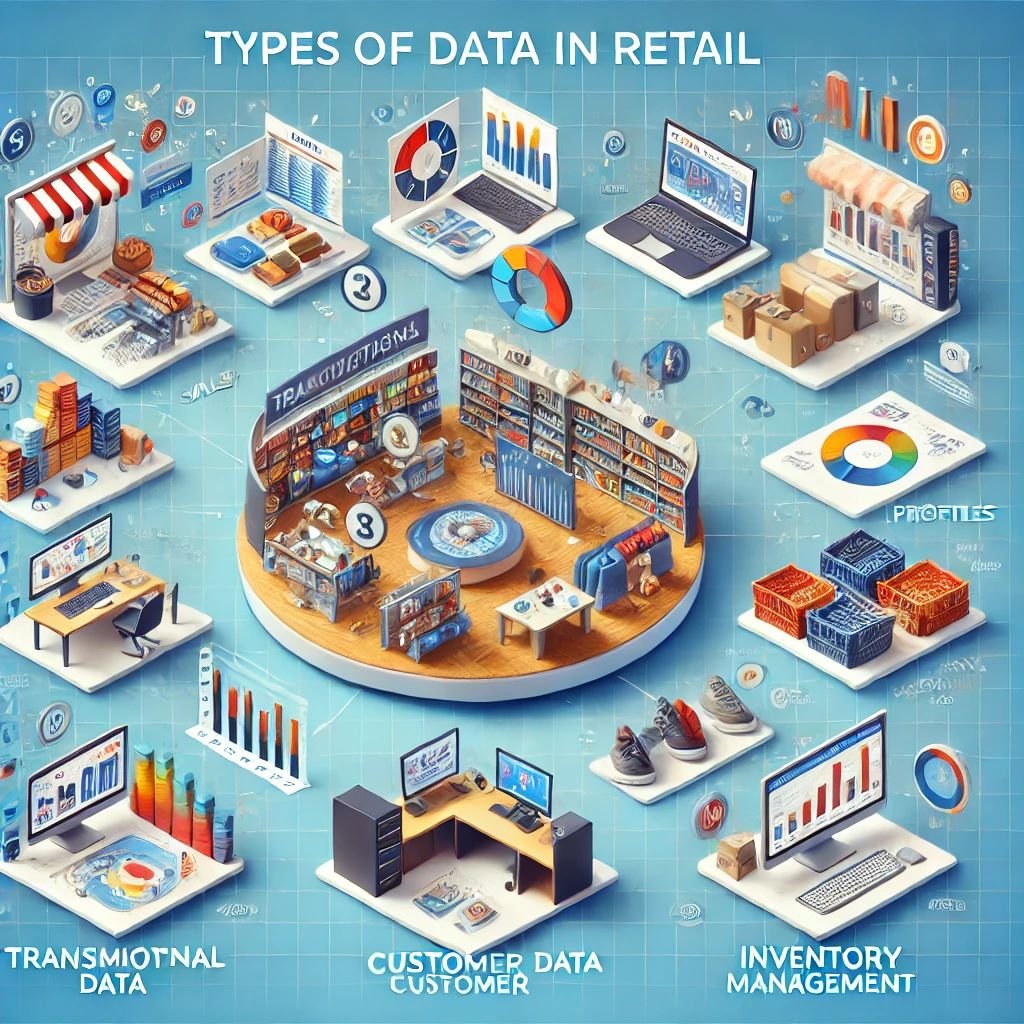
Types of Data in Retail: Transactional Data, Customer Data, and Inventory Data
In the rapidly evolving retail landscape, data has become a cornerstone of strategic decision-making.
By leveraging different types of data, retailers can optimize operations, enhance customer experiences, and drive sales growth.
This comprehensive article delves into three critical types of data in retail: transactional data, customer data, and inventory data.
Understanding these data types and their applications is essential for retailers aiming to stay competitive and responsive to market dynamics.
Transactional Data
Definition:
Transactional data refers to the data generated during the execution of business transactions.
In retail, this encompasses all the data related to sales, returns, exchanges, and other monetary interactions between the retailer and the customer.
Components of Transactional Data:
- Sales Data: Includes information about each sale transaction, such as date, time, store location, products purchased, quantities, prices, and payment methods.
- Returns and Exchanges: Data related to product returns and exchanges, including reasons for return, refund amounts, and exchange details.
- Promotions and Discounts: Information about any promotional offers or discounts applied during the transaction.
- Revenue Data: Total revenue generated from transactions over specific periods, including daily, weekly, monthly, and yearly sales figures.
Applications of Transactional Data:
- Sales Analysis:
- Trend Analysis: Retailers can analyze sales trends to identify peak selling periods, seasonal variations, and emerging product trends.
- Product Performance: By examining sales data, retailers can determine which products are performing well and which are underperforming, allowing for better inventory management and promotional strategies.
- Revenue Forecasting:
- Predictive Analytics: Transactional data can be used to forecast future sales and revenue, enabling retailers to make informed decisions about stock levels, staffing, and marketing efforts.
- Budget Planning: Accurate revenue forecasts help retailers plan budgets more effectively, ensuring adequate allocation of resources.
- Customer Insights:
- Purchase Patterns: Analyzing transactional data reveals customer purchase patterns, helping retailers understand customer preferences and behaviors.
- Loyalty Programs: Retailers can track transaction histories to reward loyal customers and tailor loyalty programs to enhance customer retention.
- Operational Efficiency:
- Supply Chain Optimization: Transactional data helps retailers optimize supply chain operations by aligning stock levels with demand patterns, reducing stockouts and overstock situations.
- Pricing Strategies: By analyzing the impact of promotions and discounts on sales, retailers can develop more effective pricing strategies.
Customer Data
Definition:
Customer data encompasses all the information related to individuals who interact with the retail brand.
This data can be collected through various touchpoints, including in-store visits, online transactions, loyalty programs, and social media interactions.
Components of Customer Data:
- Demographic Data: Includes basic information such as age, gender, income level, education, and geographic location.
- Behavioral Data: Captures customer interactions with the brand, including browsing history, purchase history, and engagement with marketing campaigns.
- Psychographic Data: Involves information about customer lifestyles, interests, values, and preferences.
- Transactional Data: As mentioned earlier, this includes details about customer purchases and interactions with the retailer.
Applications of Customer Data:
- Personalized Marketing:
- Targeted Campaigns: By analyzing demographic and behavioral data, retailers can create targeted marketing campaigns that resonate with specific customer segments.
- Personalized Recommendations: Leveraging purchase history and browsing behavior, retailers can provide personalized product recommendations, enhancing the shopping experience.
- Customer Segmentation:
- Segment Identification: Customer data allows retailers to segment their customer base into distinct groups based on characteristics such as buying behavior, demographics, and preferences.
- Tailored Strategies: Retailers can develop tailored marketing and sales strategies for each customer segment, maximizing engagement and conversion rates.
- Loyalty and Retention:
- Loyalty Programs: Customer data is crucial for designing and managing loyalty programs that reward frequent shoppers and encourage repeat purchases.
- Churn Analysis: By analyzing customer behavior, retailers can identify early signs of churn and implement retention strategies to keep customers engaged.
- Customer Service Enhancement:
- Personalized Support: Access to comprehensive customer profiles enables customer service teams to provide personalized support and resolve issues more efficiently.
- Feedback and Improvement: Retailers can collect and analyze customer feedback to identify areas for improvement and enhance overall customer satisfaction.
Inventory Data
Definition:
Inventory data refers to information about the stock levels, movements, and status of products within a retail operation.
This data is essential for managing inventory, optimizing stock levels, and ensuring product availability.
Components of Inventory Data:
- Stock Levels: Current quantity of each product in inventory, including on-hand stock, reserved stock, and incoming stock.
- Product Movements: Data on inventory transactions such as shipments received, items sold, returns, and transfers between locations.
- Stock Status: Information about the condition of stock, including items that are damaged, expired, or nearing expiration.
- Inventory Turnover: Measures how frequently inventory is sold and replaced over a specific period.
Applications of Inventory Data:
- Inventory Management:
- Stock Optimization: By analyzing stock levels and turnover rates, retailers can optimize inventory levels to meet demand without overstocking or understocking.
- Automated Reordering: Inventory data enables automated reordering systems that replenish stock based on predefined thresholds and sales forecasts.
- Demand Forecasting:
- Sales Projections: Inventory data, combined with sales data, helps retailers project future demand and adjust inventory levels accordingly.
- Seasonal Planning: Retailers can use historical inventory data to plan for seasonal variations in demand and ensure adequate stock during peak periods.
- Supply Chain Efficiency:
- Supplier Performance: Tracking inventory data helps retailers evaluate supplier performance, ensuring timely deliveries and minimizing disruptions.
- Logistics Optimization: Retailers can optimize logistics and distribution by analyzing inventory data to identify bottlenecks and streamline operations.
- Cost Management:
- Carrying Costs: Effective inventory management reduces carrying costs associated with storing excess stock, such as warehousing expenses and insurance.
- Stock Reductions: Inventory data helps identify slow-moving or obsolete stock, allowing retailers to implement strategies to reduce or liquidate excess inventory.
Integration and Analysis of Data Types
Unified Data Platforms:
To maximize the benefits of transactional, customer, and inventory data, retailers should integrate these data types into a unified data platform.
This holistic approach enables comprehensive analysis and provides a 360-degree view of the business.
Advanced Analytics and AI:
Leveraging advanced analytics and artificial intelligence (AI) techniques, retailers can gain deeper insights and predictive capabilities.
Machine learning algorithms can analyze complex data sets to uncover hidden patterns, optimize inventory, personalize customer interactions, and forecast demand.
Data-Driven Decision Making:
By integrating and analyzing transactional, customer, and inventory data, retailers can make data-driven decisions that enhance efficiency, improve customer experiences, and drive business growth.
This approach fosters agility, enabling retailers to respond quickly to market changes and customer needs.
In the modern retail environment, data is a critical asset that drives strategic decision-making and operational efficiency.
Understanding and effectively utilizing transactional, customer, and inventory data allows retailers to optimize their operations, enhance customer experiences, and stay competitive.
By integrating these data types into a unified platform and leveraging advanced analytics, retailers can unlock the full potential of their data, paving the way for sustainable growth and success in an ever-evolving market.



